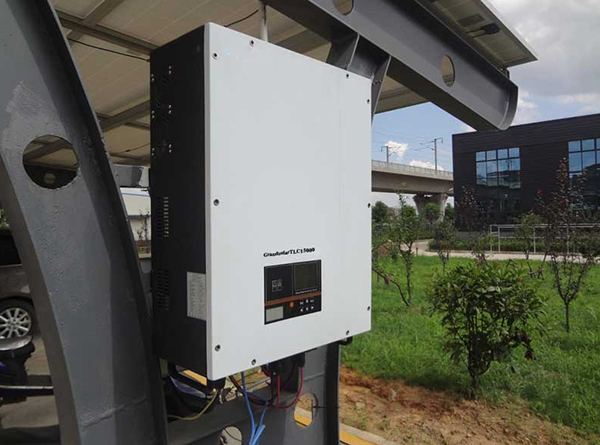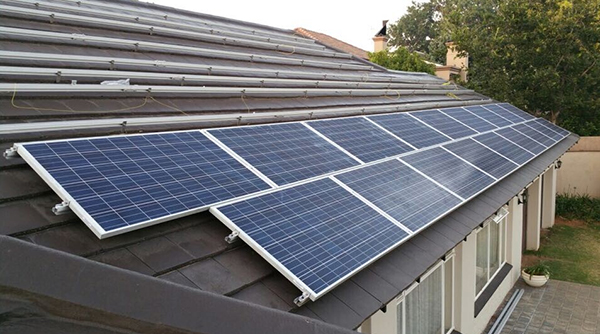The solar panels have a point on their performance curve in which they generate maximum power under a set of circumstances, and this point called (Maximum Power Point), and on the other side, the solar inverter has maximum power point tracking feature "MPPT", so it continuously searches and hunts this point to maximize the generated energy/power from your solar system. Inverter.com offers this feature for each Micro Inverter.
The sun radiation intensity varies along the day, and the solar array output varies accordingly, so the first regulation job of the inverter is to accept and regulate such change in DC electricity, trying maximize the DC energy harvest as described in aforementioned second job. Also, grid parameters like voltage, and frequency change with grid loads variation, so the second regulation job of the inverter is to regulate and synchronize all these variables, so the solar system can be connected to the grid safely within power quality specs, and with No disconnection in case of grid tie solar photo-voltaic systems. Another regulation job of the solar inverter is monitoring, and protection for both DC voltage, and AC voltage sides parameters, so it disconnects in case of faults or for safety reasons.
Solar panels are the main part in the solar system with a job to convert sun lights to DC electricity, and their costs represent a relatively considerable amount of the whole solar system price. The price of the solar panels continuously changes from year to year based on three factors.
The micro grid inverter is a small plug and play device which is usually connected to one solar panel/module to convert DC to AC electricity, and that is its mainly difference from other solar string and central inverters which can be connected to multiple solar panels. In addition, the output from several micro-inverters are always connected together to electrically feed one electrical grid panel.
Solar electricity generation system has a huge environmental benefits in avoiding carbon dioxide gas (CO2) emission, which represents significant amount releases in other conventional electricity generation source. In industrial countries, and to generate one kilo watt hour electricity from conventional energy source, an average amount of 1kg of CO2 will be released, so tones of CO2 will be emitted yearly in only one country, but in fact the actual CO2 released amount differ from one country to another and from one fuel/generation technology to another. You can imagine what will be total released amount for the whole world! And how much you save if CO2 free technology of solar electricity generation is used, it’s really great environmental benefit.
Mainly in 2 cases the solar micro inverter exhibits unique benefits; The first is when there is shading across our solar panels array, and the second is when we need our solar panels to face different directions due to our roof design. As micro solar inverter will allow every solar panel to run on its own, so if one or more solar panels are affected by shading, this will not affect the output power of our whole solar array, because other panels subjected to sunlight will still produce its maximum power capacity and will not affected by shading solar panels.
The inverter is considered as the brain of the solar system. And although there are different types of the solar inverters, but they all have the main components, let us see what are they and what are their functions as following:
1. Capacitor: It is used to filter ripples on the DC bus originated from semi-conductors switching, keep stable voltage on the DC bus, and reduce losses between the solar array and the solar inverter.
2. Monitoring Software: It used to monitor the solar system, providing the status of solar system to installer & owner, and alert them in case of faults. This software is running on inverter internal controller/processor.
3. Solid State Devices: Mainly we intend IGBTs, MOSFETs and transistor, they are used to do the inverter main job which is converting DC current to AC current.
4. Magnetic components: They include transformer and inductor to filter and smooth the AC wave shape for electrical grid connection, also they provide isolation between the DC circuit and the AC grid.
Solar companies have some trading skills that you must understand when purchasing solar systems. Let's take a look at them
1. Buy today or the biggest tomorrow and you'll get a very high special discount. This is a famous saying in the tactics of solar energy company. In this case, if you think it's a good deal, then you have to study the offer very carefully, ask the solar company a time, don't sign before you are completely sure.
2. Another tricky sentence is: the big rebate will end next week, which is almost incorrect, because in the past, the rebate was changed regularly, but now it doesn't happen anymore, because the rebate is in the form of solar energy certificate, which has become a consistent plan.
When installing solar photo-voltaic (pv) system on the roof of your new home, you need to be careful about shading.
There are a multiple of inquiries we have to get answers for from our electricity retailer when we intend to install a new solar photo voltaic system. In general, our solar installation company will know the answers of these inquires, but better to ask the retailer, and here are some of these inquires.
Solar inverter is a main device and important part of PV on grid power system. In order to ensure the normal operation of the solar PV grid tie system, the correct configuration and selection of solar inverters are particularly important. For the configuration of the solar inverter, in addition to considering the technical specifications of the entire photovoltaic power generation system and referring to the product manual, the following technical features should also be considered: rated output power, output voltage adjustability, overall efficiency and start-up performance.
The solar inverter is the safety control center of PV system. Thus, during the PV system operation, the inverter condition, including the temperature and operation of interval cavity and main element, the bus voltage and the communication among chips, shall be inspected from time to time. In addition, the insulation among components and DC system, the DC voltage and current, the AC output voltage, current and frequency shall also be inspected. In case of any failure, it shall be solved in time.

Solar inverter is an electronic product and its service life is limited due to the limit of the components. However, many inverters are damaged before the service life expires and the actual service life is shorter than the designed theoretical service life. The service life is determined by the product quality and the post-period installation, operation and maintenance conditions. So, how to improve the service life of the solar inverter?
Solar inverter shall realize the highest efficiency in wide power range conditions. Meanwhile, using a solar inverter shall meet the strict safety requirements. The property of the solar inverter is essentially determined by the accurate measurement of basic electricity. The safety criteria that shall be followed by solar inverter designers may become stricter and stricter. For instance, just like the limit on the input of DC power into the grid, some consensus may be reached on the allowable total harmonic wave of the solar inverter output current. By far, many different local limitations are put forward based on the layout situation. Thus, it requires that when the power grid frequency is greatly higher than 50Hz or 60Hz, the current shall be measured accurately.
In the solar PV grid tie system, the power of photovoltaic module is related to the inverter. The power matching between PV modules and solar grid tie inverters is not in a relationship of 1:1 fixed ratio, so it needs to be considered comprehensively based on the specific conditions of the project. The main influencing factors include irradiance, system loss, component installation angle, efficiency and life span of the on grid inverter, etc.
The AC voltage overrange is the most common failure of the solar inverter connected with the PV grid system. This is because the grid voltage is not constant and it will change with the changing of the load and current. At the same time, the output voltage of the inverter will be affected by the grid voltage. When the grid encounters abnormal situation, the inverter power supply shall be stopped to avoid more serious damage on the grid.
As a critical component of the entire solar PV power generation system, the solar inverter is a power electronic circuit that converts the direct current emitted by the solar array into the alternating current to power the AC load. The solar inverter has two primary functions: Firstly, to provide electricity for the AC load to complete the DC/AC conversion. Secondly, to find the optimal workplace to optimize the solar PV system's efficiency. The solar PV system works with an optimal voltage and current at specific solar radiation, temperature, and the solar cell to generate electricity at the maximum power. Therefore, when selecting a solar inverter for PV power generation system, it should meet the following 6 features: reasonable circuit structure, a wide range of DC input voltag, high efficiency, high reliability, pure sine wave and high overload capacity.
With advances in solar photovoltaic technology, many technical terms, in addition to solar power generation systems, PV sunshine rooms, PV greenhouses, and other civilian projects, have taken a deep root in residents' life. For instance, many purchasers ask questions when buying an inverter, for example, how many circuits of MPPT does this inverter has? What the power-generation efficiency is like? Although many people are aware of the MPPT function, they are unclear about the circuit's working principles. This paper will briefly introduce the DC-DC conversion circuit, a vital component of MPPT.
If in the PV system, the component installation place is distant from the power grid connection place and the distance is over 300m, the solar inverter can be installed at three places. The first place is the place that is most approximate to the grid connection point, which can save the AC cable. The second one is the place that is closest to the component, which can save the DC cable. The third one is the middle place. Which one is the best choice?

Basically, the solar panels are mainly consisting of several small solar cells connected electrically to each other in series. When the solar cell subjected to sunlight, it will generate direct current electricity (DC voltage), then the solar inverter takes the DC electricity and converting it to alternating current electricity (AC voltage). This AC energy will flow through your home electrical distribution panel, and distributed to flow through different branches/wires to operate your home different electrical appliances/equipment. And the following are the main 3 steps in how the solar panels will work for our home:
Generally, the solar photovoltaic system with its different types (Grid Tie, Off Grid, and Hybrid) deal with risky voltages values, its alive electricity with voltages that can hurt and cause die to human in case of direct contact. Also, there are some technical areas that needs solar professionals to deal with, like the issues related to wind loading and how the solar system can withstand this safely, how to make voltage compatibility between solar panels configurations, and how to do installation and commission for the solar inverter. One more important thing is that in order to get solar rebates for the residential solar system from your government, your solar system must be installed by professional, licensed and accredited solar system installers.


